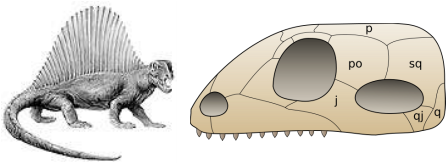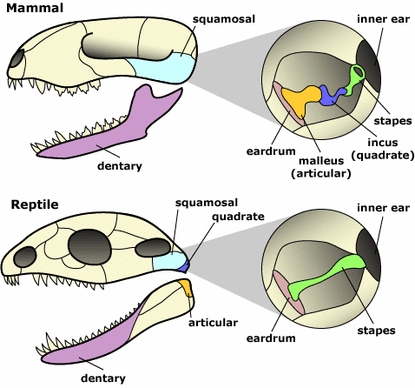Evolutionary History
The process of mammalian evolution took about 70 million years. It began in the mid Permian era (290-248 million years ago). The amniotes were the first vertebrates to live on land. A few million years later, they split into two linages - the Synapsids and the Sauropsids. The Synapsid skull had an additional hole behind the eyes to make the skull lighter. Therapsids descended from the Synapsids while dinosaurs, birds, and lizards descended from Sauropsids.
Soon the Therapsids became the dominant land veterbrates in the Triassic period. At this time, they were starting to share qualities with the modern mammal. They had a secondary palate which separated the air passage and the mouth. This allowed them to eat and breathe at the same time.
The Cynodonts were a group of Therapsids that lived in the late Permian era. They developed teeth of various shapes to perform different functions. For example, molars were used for grinding plant matter and incisors were used to cut leaves or hold on to prey.
It wasn't until the early Jurassic period (213-144 million years ago) that the first true mammals appeared. When the dinosaurs were wiped out, Saurospids such as lizards, crocodiles, and birds survived. They were smaller, great at conserving water or could fly. Small nocturnal insectivores decended from Cynodonts who descended from Therapsids also survived, and this was the big step in mammalian evolution. These insectivores were the first true mammals. They needed to maintain a regular body temperature to be active at night. Hearing and smell became important senses for nocturnal life, which led to the two bones at the back of the jaw forming the middle ear.
The Cynodonts were a group of Therapsids that lived in the late Permian era. They developed teeth of various shapes to perform different functions. For example, molars were used for grinding plant matter and incisors were used to cut leaves or hold on to prey.
It wasn't until the early Jurassic period (213-144 million years ago) that the first true mammals appeared. When the dinosaurs were wiped out, Saurospids such as lizards, crocodiles, and birds survived. They were smaller, great at conserving water or could fly. Small nocturnal insectivores decended from Cynodonts who descended from Therapsids also survived, and this was the big step in mammalian evolution. These insectivores were the first true mammals. They needed to maintain a regular body temperature to be active at night. Hearing and smell became important senses for nocturnal life, which led to the two bones at the back of the jaw forming the middle ear.
Brains increased in weight and became more complex due to development of the ears and consumed more energy to maintain body temperature. Sight was not as important for hunting at night, leading to poor colour vision.
Not much is known about the development of mammary glands or the neocortex region in the brain because tissues are not preserved in fossils.
Not much is known about the development of mammary glands or the neocortex region in the brain because tissues are not preserved in fossils.


